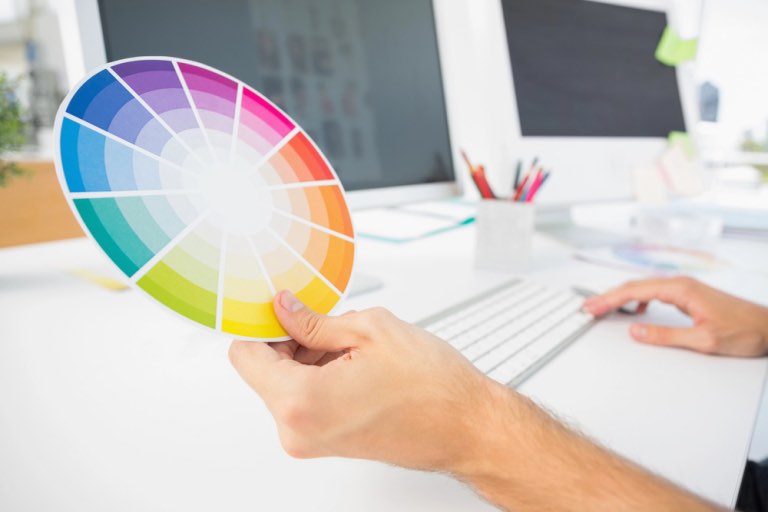How to Combine Colors Efficiently: Introduction to Color Theory

When used wisely, color can become a powerful design tool that plays a huge role in setting the mood for your projects. However, to achieve this, you must understand how colors work together, which combinations are a good option, and which ones to avoid. By grasping the basics of color theory, you learn how to create harmonious color schemes, evoking the desired emotions and responses.
In this article, you’ll explore the basics of color theory and color combinations, and find insights for selecting appealing black color combinations to enhance your designs. Read on!
How to combine colors to achieve an aesthetic color palette
Color theory is a set of principles and guidelines that help creators understand how colors interact with each other. It includes the study of color mixing, contrast, harmony, and the psychological effects of colors. The color wheel, in turn, is a visual representation of color theory principles. It shows how color combinations work and relate to each other.
For instance, gold on the color wheel can work as a part of various color combinations and help achieve different effects, e.g., when paired with deep blues and rich purples, gold can evoke a sense of opulence and luxury. Overall, there are six main color combinations:
Complementary colors
These are the colors that are opposite to each other on the color wheel. For instance, it could be red and green, blue and orange, or yellow and purple color combinations. When used together, such duos create contrast and vibrancy, making each of them look more intense.
Split-complementary colors
These colors are similar to complementary, but have one difference—they use one base color and two adjacent to its complement. For instance, instead of combining red with green, you might consider pairing it with blue-green and yellow-green. This combination helps maintain color contrast and look a bit more subtle and harmonious.
Analogous colors
This is the combination of colors that are adjacent to each other on the color wheel—for instance, red, orange, and yellow. These colors generally share a similar hue and create a harmonious and unified palette. Designers and content creators often combine them to achieve a cohesive look.
Monochromatic colors
One of the most common monochromatic color combinations is black and white. While white is the most overlooked color in the world, which only about 8% of people notice, it’s still a great option for color schemes of such sort. The other examples of monochromatic schemes are variations of a single hue—for instance, different shades, tints, and tones of red. While these combinations might lack contrast, they are still elegant, sophisticated, and simple.
Triadic colors
This combination includes colors that are evenly spaced around the color wheel and form an equilateral triangle when connected. For instance, this could be a color scheme consisting of red, blue, and yellow, creating a triadic scheme. Such combinations offer high contrast and, at the same time, maintain balance and vibrancy.
Tetradic colors
This color combination is also known as double complementary colors. It involves two pairs of complementary colors that create a dynamic and versatile palette, but at the same time have to be balanced carefully to avoid overwhelming the composition. For instance, this could be red and green colors paired with blue and orange, or yellow and purple paired with cyan and magenta.
FAQ: What colors work well together?
Most often, complementary colors (opposites on the color wheel) or analogous colors (neighbors on the color wheel). These combinations create harmonious palettes.
FAQ: What colors do not go together?
These are usually colors that clash or create visual discomfort when paired together. These could also be colors that are too similar in hue or saturation, or combinations that lack contrast, such as red and green or orange and purple.
The most popular color combinations with black
Black is one of the most universal colors, and it can be included in numerous combinations to achieve various atmospheres and effects. Here are the most common color combinations with black.
1. Black and white
This is a timeless, classic combination. It works well for formal events, professional settings, or minimalist designs. You can use black to highlight bold elements and white to create clean backgrounds or accents.
2. Black and blue
Blue is currently the most popular color worldwide, with 35% of people claiming it to be their favorite. The combination of blue and black creates a sleek and sophisticated look that is perfect for business attire, corporate branding, or modern interiors. You can use black as the dominant hue and add blue accents for a pop of color and depth.
3. Black and gold
The color gold is often associated with luxury, elegance, and sophistication, especially when it’s combined with black. Black and gold symbolism is commonly used in high-end fashion, luxury branding, or for formal events. You can use black as a backdrop to showcase gold accents or decorations, achieving a glamorous aesthetic.
4. Black and red
If you want to create a sense of power, passion, and intensity, the black and red color combination can be a perfect choice. This color scheme is often used in fashion, sports branding, or high-energy designs. You can use black as the base and add red to create striking accents.
5. Black and green
Black and green color combinations create a sense of balance and harmony, representing nature and growth. This combination works well for eco-friendly brands, outdoor products, or calming environments. In this case, you can use black as a grounding color and add green accents for a fresh and vibrant touch.
FAQ: Which three color combinations are the best?
This largely depends on the context and the impression you want to create. If you’re planning to use primary colors, you can pick red, blue, and yellow. If you want to focus on pastel shades, try sky blue, pale yellow, and light pink. If you are a fan of nature-inspired tones, consider combining brown, green, and tan.
To sum up
Every creator needs to understand color theory to know how their visuals can impact viewers. When you know the true meaning of colors, for example, gold, black, or purple, and the common associations with their hues, you can create inspiring visuals that can influence your target audience.
Understanding color psychology can also help you evoke specific emotions or convey messages effectively. Make sure to grasp the color theory basics and use different hues confidently in your designs.





